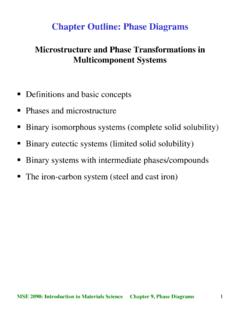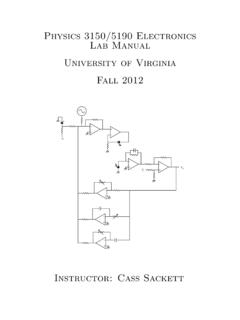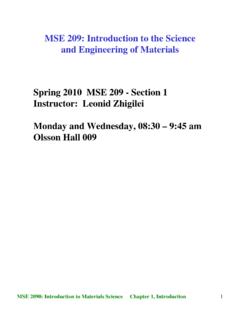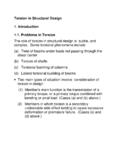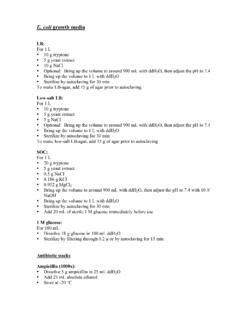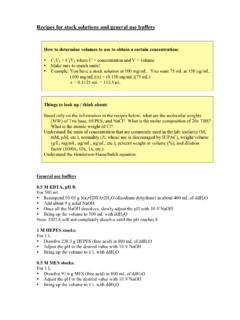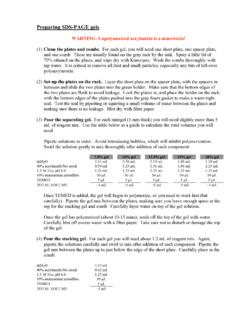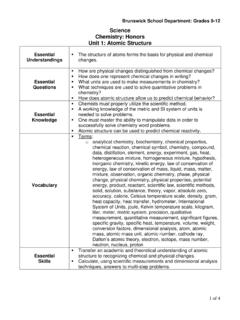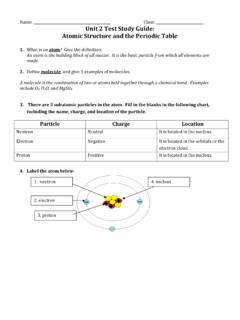Transcription of Chapter Outline Review of Atomic Structure
1 Chapter Outline Review of Atomic Structure Electrons, protons, neutrons, quantum mechanics of atoms, electron states, the periodic Table Atomic Bonding in Solids Bonding energies and forces Primary Interatomic Bonding Ionic Covalent Metallic Secondary Bonding Three types of dipole-dipole bonds Molecules and molecular solids Understanding of interatomic bonding is the first step towards understanding/explaining materials properties MSE 2090: Introduction to Materials Science Chapter 2, Bonding 1. Nature of Interatomic Bonding Why the individual atoms coalesce into larger structures and take on the characteristics and properties of many different materials?
2 People were trying to answer this question for well over two millennia, since the time of the Atomic hypothesis of Democritus, 440 * Roman poet Lucretius (95-55 ) wrote in De Rerum Natura (On the Nature of Things): What seems to us the hardened and condensed Must be of atoms among themselves more hooked, Be held compacted deep within, as it were By branch-like atoms- of which sort the chief Are diamond stones, despisers of all blows, And stalwart flint and strength of solid iron . John Dalton (1766-1844) found the evidence of those "hooks in his quantitative chemical measurements, making the foundation of modern Atomic theory of matter.
3 * the idea that everything is made of distinct atoms has been a subject of skeptical discussions as recently as the beginning of the twentieth century, before Einstein's observation of Brownian motion in 1905 and Max von Laue's observation of the diffraction of X-rays by crystals in 1912 provided strong support for the atomistic theory. MSE 2090: Introduction to Materials Science Chapter 2, Bonding 2. Structure of atoms: Brief Review The bonding mechanisms between atoms are closely related to the Structure of the atoms themselves. Atoms = nucleus (protons and neutrons) + electrons Charges: Electrons and protons have negative and positive charges of the same magnitude, 10-19 Coulombs.
4 Neutrons are electrically neutral. Masses: Protons and Neutrons have the same mass, 10-27 kg. Mass of an electron is much smaller, 10-31 kg and can be neglected in calculation of Atomic mass. The Atomic mass (A) = mass of protons + mass of neutrons # protons gives chemical identification of the element # protons = Atomic number (Z). # neutrons defines isotope number MSE 2090: Introduction to Materials Science Chapter 2, Bonding 3. Atomic mass units. Atomic weight. The Atomic mass unit (amu) is often used to express Atomic weight. 1 amu is defined as 1/12 of the Atomic mass of the most common isotope of carbon atom that has 6.
5 Protons (Z=6) and six neutrons (N=6). Mproton Mneutron = x 10-24 g = 1 amu. The Atomic mass of the 12C atom is 12 amu. The Atomic weight of an element = weighted average of the Atomic masses of the atoms naturally occurring isotopes. Atomic weight of carbon is amu. The Atomic weight is often specified in mass per mole. A mole is the amount of matter that has a mass in grams equal to the Atomic mass in amu of the atoms (A mole of carbon has a mass of 12 grams). The number of atoms in a mole is called the Avogadro number, Nav = 1023. 1 amu/atom = 1 gram/mol Example: Atomic weight of iron = amu/atom = g/mol MSE 2090: Introduction to Materials Science Chapter 2, Bonding 4.
6 Some simple calculations The number of atoms per cm3, n, for material of density d (g/cm3) and Atomic mass M (g/mol): n = Nav d / M. Graphite (carbon): d = g/cm3, M = 12 g/mol n = 6 1023 atoms/mol g/cm3 / 12 g/mol = 1022. atoms/cm3. Diamond (carbon): d = g/cm3, M = 12 g/mol n = 6 1023 atoms/mol g/cm3 / 12 g/mol = 1022. atoms/cm3. Water (H2O) d = 1 g/cm3, M = 18 g/mol n = 6 1023 molecules/mol 1 g/cm3 / 18 g/mol = 1022. molecules/cm3. For material with n = 6 1022 atoms/cm3 we can calculate mean distance between atoms L = (1/n)1/3 = nm. the scale of Atomic structures in solids a fraction of 1 nm or a few A.
7 MSE 2090: Introduction to Materials Science Chapter 2, Bonding 5. Electrons in Atoms (I). The electrons form a cloud around the nucleus, of radius of 2 nm. This picture looks like a mini planetary system. But quantum mechanics tells us that this analogy is not correct: Electrons move not in circular orbits, but in 'fuzzy orbits. Actually, we cannot tell how it moves, but only can say what is the probability of finding it at some distance from the nucleus. Only certain orbits or shells of electron probability densities are allowed. The shells are identified by a principal quantum number n, which can be related to the size of the shell, n = 1 is the smallest; n = 2, 3.
8 Are larger. The second quantum number l, defines subshells within each shell. Two more quantum numbers characterize states within the subshells. MSE 2090: Introduction to Materials Science Chapter 2, Bonding 6. Electrons in Atoms (II). The quantum numbers arise from solution of Schrodinger's equation Pauli Exclusion Principle: only one electron can have a given set of the four quantum numbers. The number of available states in electron shells & subshells Principal Number Number of Electrons Q. N., n Subshells of States Per Subshell Per Shell 1 (l=0) K-shell s 1 2 2.
9 2 (l=0) s 1 2 8. 2 (l=1) L-shell p 3 6. 3 (l=0) s 1 2 18. 3 (l=1) M-shell p 3 6. 3 (l=2) d 5 10. 4 (l=0) s 1 2 32. 4 (l=1) p 3 6. N-shell 4 (l=2) d 5 10. 4 (l=3) f 7 14. Each orbit or shell can accommodate only a maximum number of electrons, which is determined by quantum mechanics. In brief, the most inner K-shell can accommodate only two electrons, called s-electrons; the next L-shell two s-electrons and six p-electrons; the M-shell can host two s-electrons, six p- electrons, and ten d-electrons; and so on. MSE 2090: Introduction to Materials Science Chapter 2, Bonding 7.
10 Electrons in Atoms (III). Subshells by energy: 1s,2s,2p,3s,3p,4s,3d,4s,4p,5s,4d,5p,6s,4 f, . Electrons that occupy the outermost filled shell the valence electrons they are responsible for bonding. Electrons fill quantum levels in order of increasing energy (only n, l make a significant difference). Examples: Argon, Z = 18: 1s22s22p63s23p6. Iron, Z = 26: 1s22s22p63s23p63d64s2. MSE 2090: Introduction to Materials Science Chapter 2, Bonding 8. Electrons in Atoms (IV). Element Atomic # Electron configuration Hydrogen 1 1s 1. Helium 2 1s 2 (stable).
